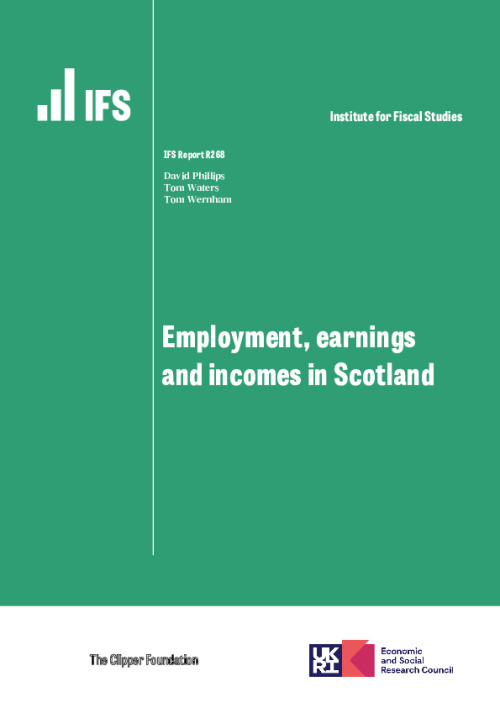Reductions in poverty – particularly among children – and inequalities in incomes and opportunities across people and places are key aims of the Scottish Government’s National Strategy for Economic Transformation. In this context, this report examines how the levels of and trends in employment, earnings and incomes vary across Scottish households and local authority (LA) areas, and how Scotland performs relative to the rest of the UK.
Key findings
1. Between the mid 1990s and the 2008 recession, employment in Scotland rose, closing the gap and then eventually overtaking the rest of the UK (rUK). Median (middle) household earnings showed a similar picture. In recent years, however, there has been a slowdown in Scottish performance relative to rUK. The gap between Scottish and rUK earnings has reduced, and employment in Scotland has fallen behind rUK once again.
2. Although in recent years median household earnings in Scotland among working households have been above those of rUK, median household disposable income – taking account of earnings, benefits, other income sources, and taxes – has been very similar, following fast growth in the early 2000s which closed the small gap that had existed previously. Mean disposable income, however, has remained consistently lower as Scotland has had less growth in very high incomes.
3. Scotland has consistently had a higher prevalence of household worklessness than rUK, despite having a similar individual employment rate for most of the past two decades. Before the pandemic, 72% of Scots were living in a working household, compared with 76% of people in rUK. There are almost 190,000 fewer Scots in working households than there would be if Scotland had the same proportion as rUK.
4. Inequality in household disposable income has generally been slightly lower in Scotland than in rUK over the last 25 years, but in the run-up to the pandemic the gap was closing. Just before the pandemic, Scotland had the same level of inequality as rUK with London excluded. Higher household worklessness in Scotland partially offsets significantly lower inequality in earnings among households in work.
5. Scotland’s lower disposable income inequality is driven by less inequality between the middle and top of the distribution – the gap between the bottom and middle is much more similar to rUK’s. Nonetheless, once we account for Scotland’s lower housing costs, Scotland has a lower poverty rate. Just before the pandemic, the Scottish relative poverty rate was 19%, 3 percentage points below that of rUK. Scotland also has lower rates of material deprivation than rUK.
6. It is too early to see much of the impact of recent changes to Scottish tax and benefit policy in official income data. But these reforms are likely to have a significant effect and reduce inequality, with low-income families with children receiving substantial boosts to their incomes as a result of benefit changes.
7. There are significant geographic inequalities in employment, earnings and incomes across Scottish LA areas. Differences in employment and earnings have narrowed somewhat over time though, and are lower than in rUK, albeit somewhat higher than in the Midlands, North, Wales and Northern Ireland.
8. Employment rates are highest in the Orkney Islands (81%) and Eilean Siar (82%), but below 70% in parts of Central and South Western Scotland. Such differences in employment rates across LAs have been persistent over time: 8 of the 10 LAs with the lowest employment rates between 2004 and 2006 were still in the bottom 10 in the period between 2020 and 2022. But there has been somewhat more churn than in the rest of Great Britain, with increases in employment rates in Glasgow and many of its deprived neighbours (where employment rates were particularly low in the mid 2000s) and falls in employment rates in most of the North of Scotland over this period.
9. Much of the decline in employment in the North of Scotland (and much of the increase in Glasgow and its environs) has taken place since the mid 2010s, a time during which employment rates have increased in most of rUK. As a result, the employment rate in both North Eastern Scotland and the Highlands & Islands fell by 6 percentage points relative to rUK between 2013–15 and 2020–22, explaining most of the relative fall in employment in Scotland as a whole over this period.
10. Mean hourly earnings in 2020–22 were lowest in Dumfries & Galloway (£16.10), Scottish Borders (£16.60) and Argyll & Bute (£16.70) and highest in East Renfrewshire (£26.30), East Dunbartonshire (£23.20) and Edinburgh (£21.40), although the majority of LAs (21 out of 32) lay between £17 and £19 during this period. Despite earnings being lowest in rural parts of Southern and Western Scotland, rural areas of Scotland generally perform relatively well compared with those in rUK. For example, among those LA areas with a population density of less than 100 people per square kilometre, Scottish LAs make up 6 of the 10 with the highest mean hourly earnings, but only 1 of the 10 with the lowest mean hourly earnings (Dumfries & Galloway).
11. Mean hourly earnings increased by more than average in virtually all Scottish LAs between 2002–04 and 2013–15, with 19 out of 32 Scottish LAs seeing an increase of at least 5 percentage points more than the rUK average during this period. Since the mid 2010s though, growth in earnings has slowed relative to rUK, especially in the North of Scotland. Indeed, between 2015 and 2022, mean monthly earnings in North Eastern Scotland fell from 130% to 114% of the average outside of London, and those in the Highlands & Islands from 94% to 90%, whereas in the rest of Scotland they broadly kept pace with growth in mean monthly earnings outside of London.
12. Mean household income per person is highest in North Eastern Scotland, parts of Lothian and the more affluent suburban LAs near Glasgow. 26 of Scotland’s LAs have mean household incomes below the rUK average, but all bar 2 (Glasgow and Dundee) have levels at or above the average for the Midlands, North, Wales and Northern Ireland.
13. There is unsurprisingly a positive correlation between mean hourly earnings and mean household income per person, but this correlation was lower in 2019–21 (0.58) than in 2002–04 (0.81). This may reflect the importance of trends in income from other sources, such as pensions and pensioner benefits, and stronger income growth among pension-age than among working-age adults.











